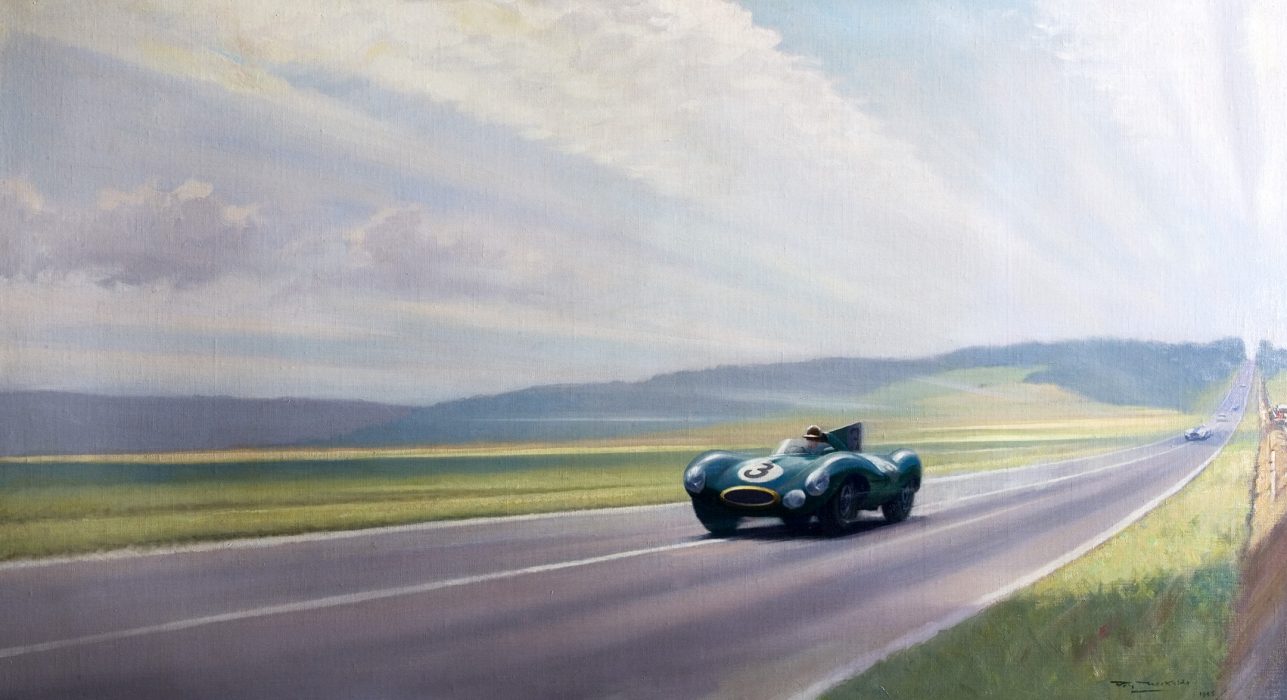
D-type No 3 at Reims, Roy Nockolds, 1954
The Artwork
This is one of nine paintings by artist Roy Anthony Nockolds in the Jaguar Daimler Heritage Trust’s Collection, most of which were commissioned by Jaguar Cars. It depicts the then new Jaguar D-type, car #3 which won the 1954 Reims 12 Hour Race.
Jaguar took the first three places at Reims and Nockolds has chosen to show the winning car driven by Peter Whitehead and Ken Wharton in the open countryside that surrounds the road circuit. The D-type is almost incidental in the landscape but we are left in no doubt that it is moving fast into the centre of the frame and about to exit left at speed. Note the use of clouds in perspective to move the picture along. Nockolds is reported as having a photographic memory and was fascinated by clouds and aircraft. He once told his niece that he could look at a cloud, remember it and draw it accurately in his return to the studio.
The painting is currently on public display in the Collections Centre at the British Motor Museum at Gaydon.
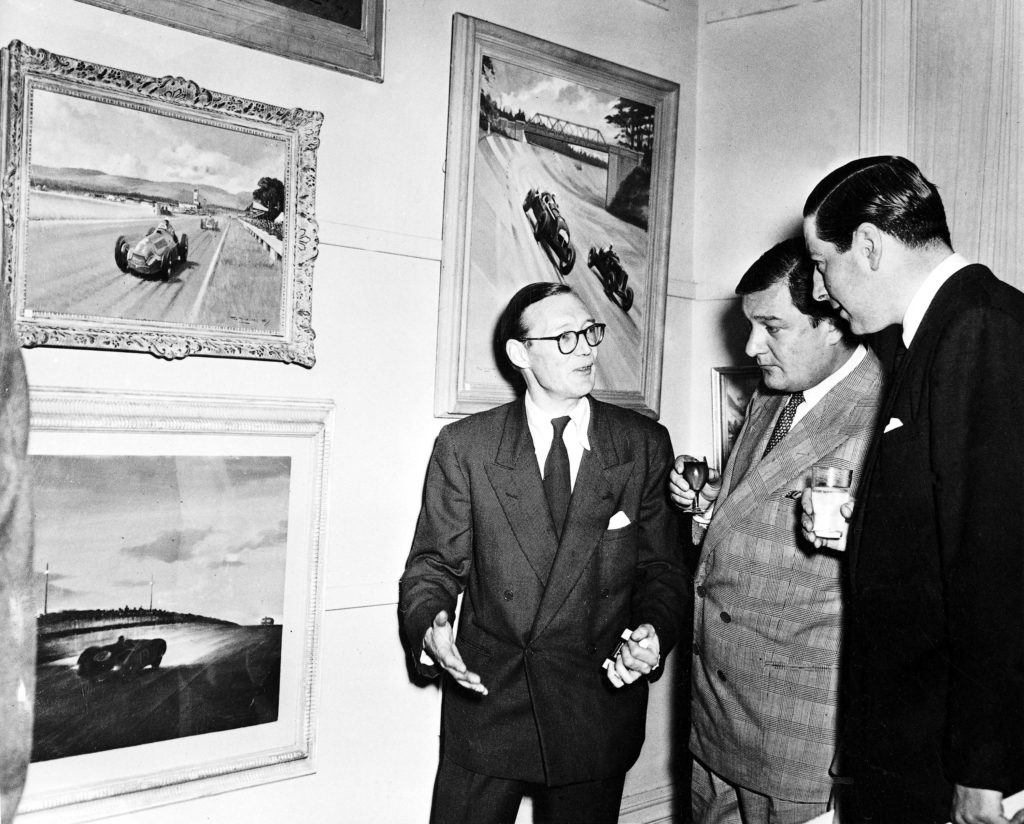
The Artist
Roy Nockolds was born in Croydon in 1911. He always claimed that his only successful subject was art and this was confirmed by two certificates from the Royal Drawing Society in 1922 (age 11) and 1923 (age 12). According to Nockolds’ recollections he first visited Brooklands in 1924 (age 13) where he became impressed by the power and speed of the racing cars and within two years, he was producing motoring art. By the time he was in his teens he was getting his pictures published in the motoring press. His early work was mainly pencil and charcoal drawings, but he also used ink, scraperboard, lino cut and dry point etching as well as watercolours.
F Gordon Crosby was already illustrating for The Autocar and Nockolds was fortunate to have most of his early work published by Motor Sport and Light Car. Although to his credit, Autocar was publishing full page reproductions of some of his etchings in 1932 (age 21). The first recorded exhibition of his work was in December 1934 at the Lombard Restaurant, Cheyne Walk, Chelsea. Around this time he was working as a freelance artist although some of his work was being used by The Motor to illustrate a weekly series of famous corners on racing circuits.
The start of war in 1939 brought a cessation of motor racing for the duration and Nockolds carried on working from his London studio as a general illustrator and for the services, particularly the RAF producing propaganda art.
In 1942 he was asked to look at improving the camouflage of night fighters. He noticed that a white owl was more difficult to see against a night sky than a dark bird. His idea was to paint the leading edge of the wing and underside of the aircraft white and the top of the aircraft black making it difficult to see from above and below. He prepared a painted model of a De Haviland Mosquito aircraft which was transferred to a full sized plane, resulting in the whole of 151 Mosquito Squadron being converted to the new scheme within days. Other camouflage work led to him being called up into the RAF at the end of 1942, initially as a Clerk, but by 1943 he was posted to the aircraft research station at Farnborough where he had civilian status. He continued the propaganda paintings and his work on camouflage of aircraft, particularly bombers and accepted commissions to supplement his income. The end of the war saw the restart of racing and he resumed his motoring artworks including commissions from car makers such as Ford, Standard, Rover, Rolls-Royce and the Rootes Group and component manufacturers such as Lockheed and Lucas.
It was during this period that he was commissioned by Jaguar and some of the sponsors and suppliers to produce all the paintings that we have in our Artwork Collection. Nockolds’ connection with Jaguar began when the Esso Petroleum Company commissioned him to depict Le Mans 1951 when Peter Walker and Peter Whitehead drove their C-type through pouring rain to give Jaguar their first victory at Le Mans. He then worked closely with Jaguar’s PR Manager Ernest (Bill) Rankin for the next decade undertaking a series of commissions, many of race winning situations but also pictures for calendars, Christmas cards and advertising posters. He was a master of combining light and texture into his work to give the impression of speed and this comes across in several of our paintings.
His work was displayed in many exhibitions in the UK and twenty-four of his paintings were exhibited in New York in 1960 in an exhibition entitled ‘British Motoring Achievements’. This was a collection of paintings depicting outstanding performances of British cars during the previous ten years including some of our race winning Jaguar pictures.
Nockolds took a very keen interest in the Brooklands society founded in 1967, being an early Committee Member and the Chairman from 1976 to 1978, only resigning with the onset of ill health. He was elected Chairman of the Guild of Aviation Artists in 1975, and continued to paint late into his life before passing away in 1979.
Jaguar and the Reims 12 Hour Race
When Jaguar decided to go endurance racing from 1951 the most important European endurance races were the 24 Hours Race at Le Mans, the 12 Hours at Sebring , USA and the 1000 km at Nürburgring.
Stirling Moss had driven Tommy Wisdom’s XK120C (C-type) to victory in the GP race at Reims in 1952. For 1953 the Reims race was changed from GP format (approx 2 hours) to become a full 12 hour endurance race. This was won by a privately entered C-type driven by Stirling Moss and Peter Whitehead.
For 1954 Jaguar entered a Works Team of three of their newly developed D-types and it was car # 3 driven by Peter Whitehead and Ken Wharton that won the race and is depicted in this painting. The D-type driven by Duncan Hamilton and Tony Rolt finished second. Third place went to the Jaguar C-type of Ecurie Francorchamps driven by Roger Laurent and Jacques Swaters. The third Works D-type driven by Stirling Moss and Peter Walker failed to finish with a broken halfshaft.
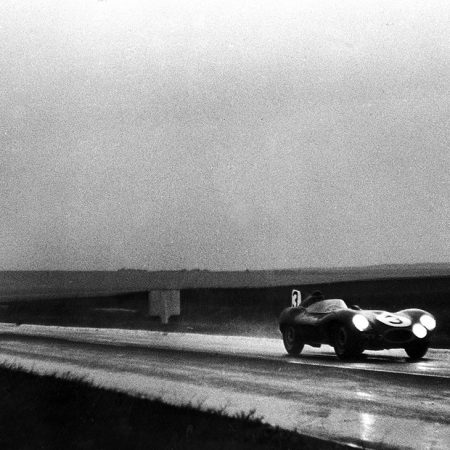
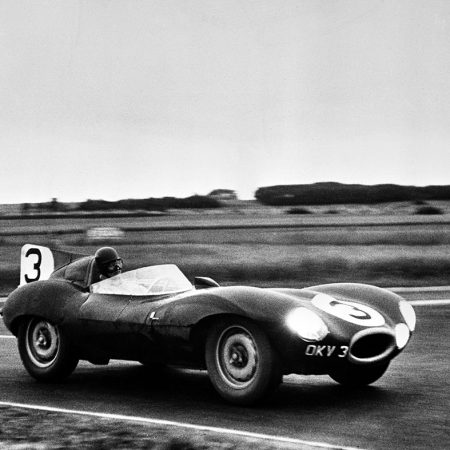
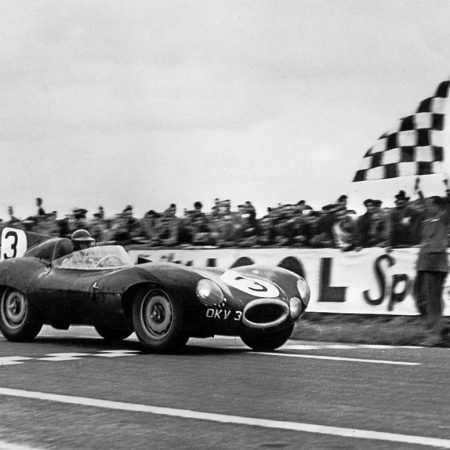
Whitehead / Wharton’s winning car # 3, chassis number XKC404, registered OKV 3, was one of the first five D-types built in 1954, all of which had XKC chassis numbers. From car 406 onwards the prefix was changed to XKD. XKC404 had been entered for Le Mans but failed to finish with transmission problems. Following Reims it was raced at the Brighton Speed Trials and Prescott hill-climb in September. It went back to the factory in October and was extensively rebuilt before being tested at Goodwood and was exhibited at the Brussels Motor Show in early 1955, after which it returned to racing for 1955 and 1956. It was sold to John Coombs in February 1957 and then changed hands a number of times before it ended up being raced in Africa from 1959 to 1961.
It returned to the UK in 1966 and was rebuilt at the factory, again following a crash at Prescott. It continued to be raced throughout the 1970s and 1980s around Europe and New Zealand before ending up in the USA in 1998. More recently it was exhibited at Quail Lodge in 2011, the 2014 Goodwood Revival and is now believed to be in a private collection in the UK.
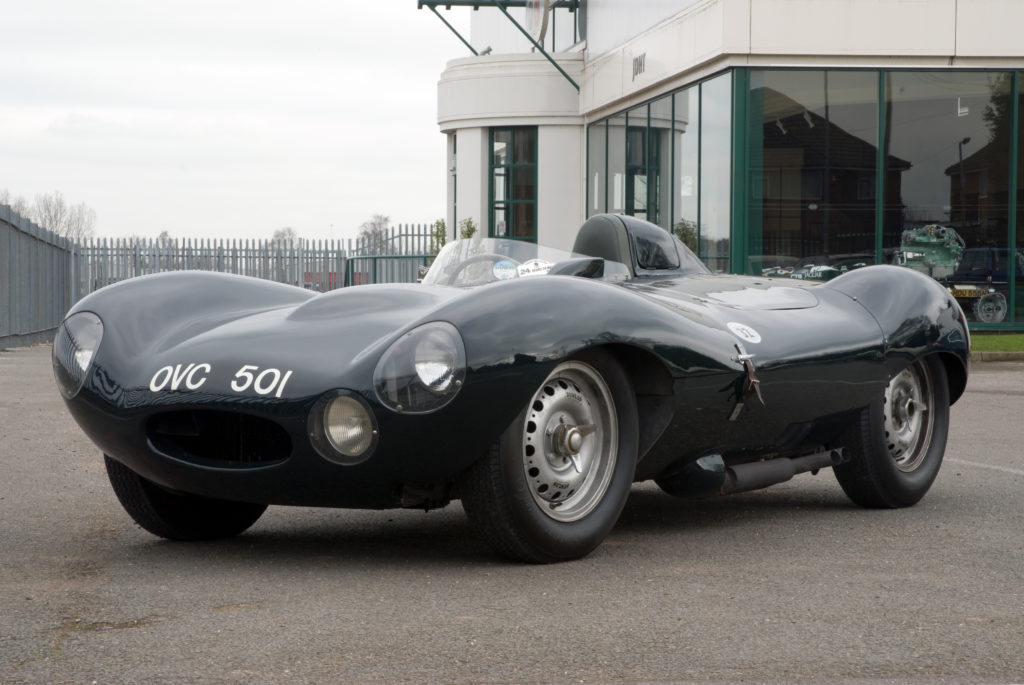
1954 D-type OVC 501 – Chassis XKC401
The Jaguar Daimler Heritage Trust has D-type XKC401, registered OVC 501, the prototype D-type and sister car to the one in the painting, in its collection.
Chassis XKC401 was completed in May 1954, and immediately travelled to France for a Le Mans test session where Jaguar works driver Tony Rolt broke the lap record by five clear seconds. On its return to Coventry, it was used for more development work including the rear fin, which became a trademark of D-types, while a further three D-types including XKC404 were built for the Works Team.
As the later D-types were described as “long-nose” cars, this and the other early ones are now retrospectively known as “short-nose”.
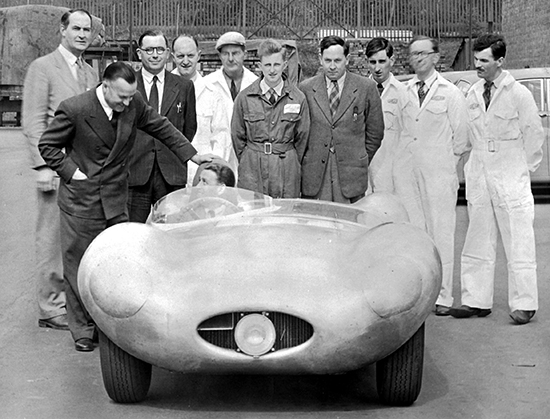
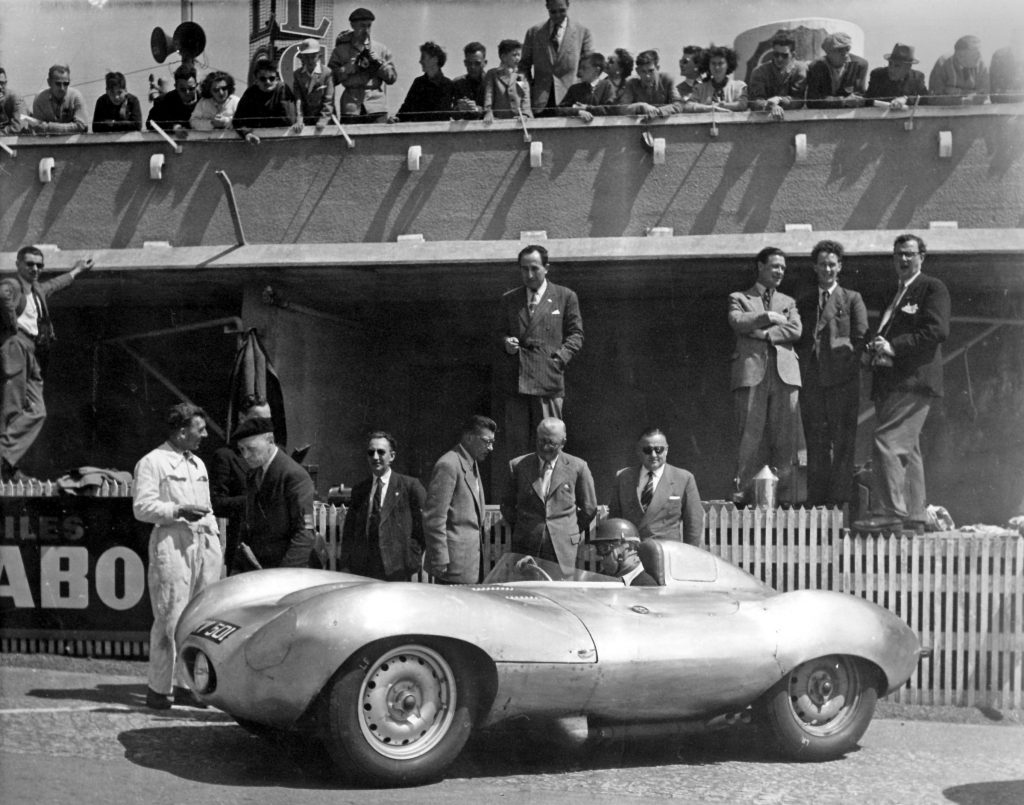
Click the button for more information on OVC 501 (XKC401):